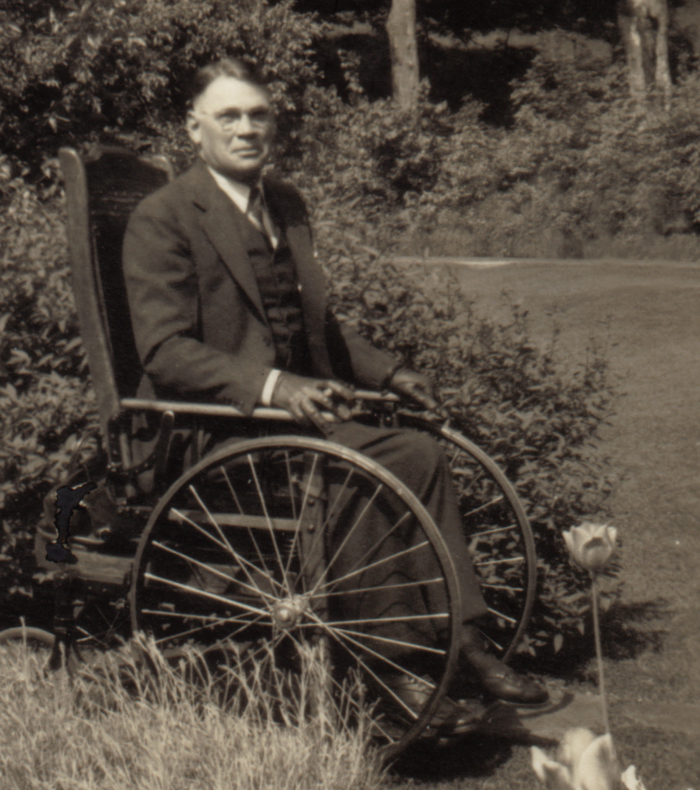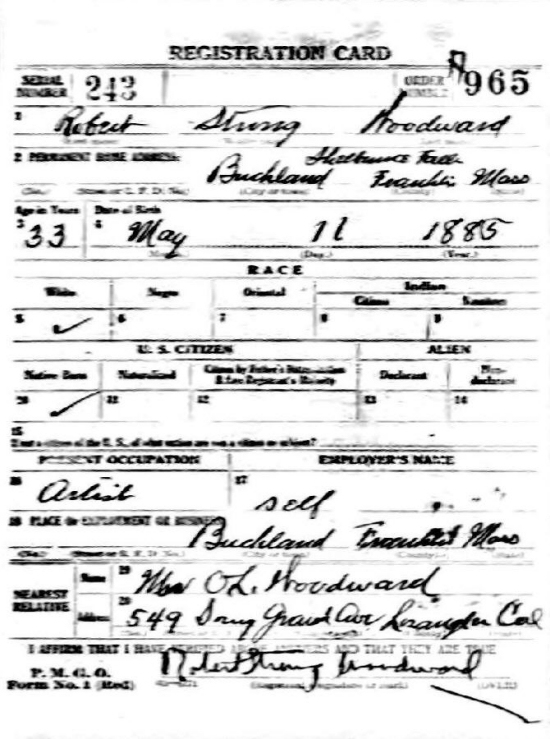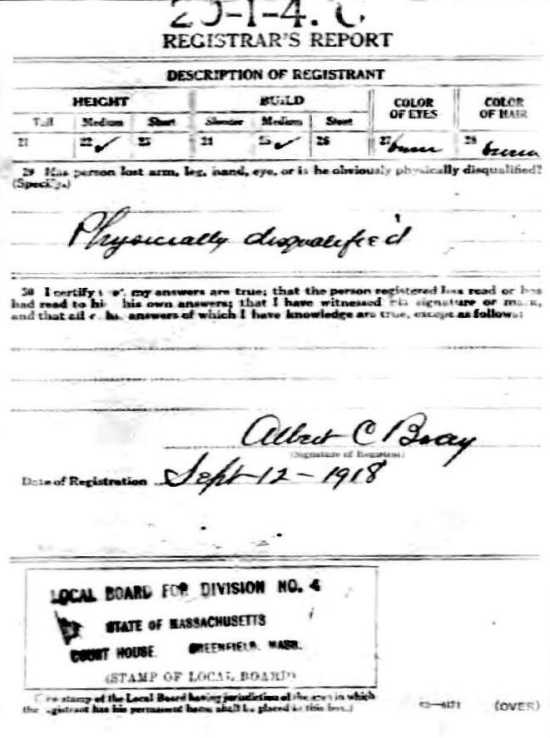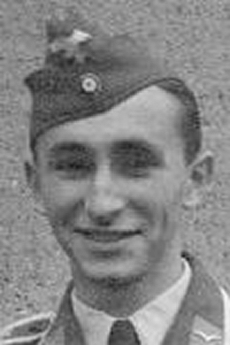Robert Strong Woodward was 29 at the outset of the Great War in 1914. Prior to 1917, the United States Army was small and comprised of volunteers. The first Selective Service registration was for all men between the ages of 21 and 31. Robert Strong Woodward was over 31 at that point.
In August 1918, the U. S. Congress amended the law to require registration of all men between the ages of 18 and 45 to register on September 12, 1918. His draft registration card is below.
Twenty two years later, the first peacetime draft was signed by Franklin Roosevelt in 1940 and required the registration of all men between the ages of 21 and 36. At age 55, Robert Strong Woodward was exempt. However, after the United States entered World War II, the Selective Service Act was modified to make all American men between the ages of 18 and 45 liable for military service and to require all men between 18 and 65 to register. Robert Strong Woodward's registration card from 1942 is shown below.
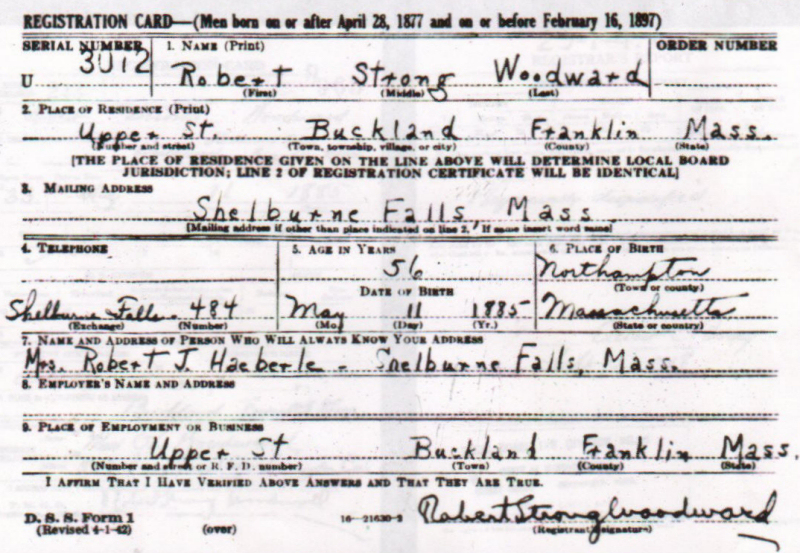
Robert Strong Woodward's Selective Service Registration Card. The form is for men between the ages of 45 and 65
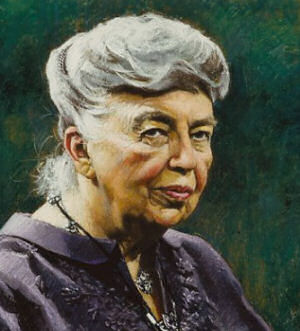
First Lady Eleanor Roosevelt (1884-1962)
Potrait by Daniel E. Greene
I started to work for Robert Strong Woodward as a lawn boy when I was in my 6th grade in 1937.
(Click here for my story). I worked my way up to more and more responsibilities. As soon as I got my license at age 16, I was taught to drive the large
Packard and "chauffeur" was added to my duties sometime in 1942. I was extremely excited and proud to drive that huge luxury vehicle in the early days of World War II. When I would take him out in the Packard for a day of painting or errands in Greenfield, we would often meet the postman, Mr. Graves, coming up from Shelburne Falls, in his beech wagon postal delivery vehicle. The Chevy would pull up alongside the great Packard, and he would hand over the tied-up mail for RSW which he had ready to deliver to the post box outside the Southwick Studio on Upper Street. Always in the bundle would be a copy of the daily newspaper with an article by Eleanor Roosevelt,
"My Day" (please click to read a sample), which he would read aloud as we proceeded along to our destinations. RSW was a big fan of the First Lady and always followed her activities.
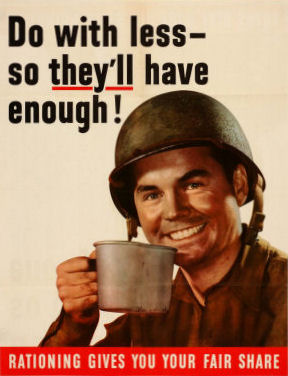
WW II era poster encouraging rationing
The Office of Price Administration (OPA) was established in the summer of 1941. The war had started in both the European and Pacific theaters, but so far the United States was not directly involved. Four days after the December 7th attack on Pearl Harbor, the OPA began to institute a rationing system, temporarily prohibiting the sales of automobile tires. The most immediate concern for rationing was the shortage of rubber. The Japanese had easily conquered the islands of the South Pacific where rubber is produced. Government rationing boards were created across the country with each board receiving an allotment of tires to be distributed to applicants. Soon that included automobiles, typewriters, bicycles and home appliances. The manufacturing factories began to convert to the production of war materials. By June of 1942, nearly all factories stopped the production metal items for civilian use.

WW II era poster encouraging Driving Clubs
Ration books began to be distributed starting with the rationing of sugar. Each member of a family received one half pound of sugar per week. The nationwide speed limit, the "Victory Speed," was set at 35 mph and everyone was encouraged to join car pools called "Driving Clubs." To qualify for a gasoline ration book, a person had to appear before the local War Price and Rationing Board and make a case why he would have a need for gasoline and swear that he owned no more than five tires. Extra tires were confiscated. Car owners that could prove the need to drive, but that the use of their car was non-essential to the war effort, were granted an "A" sticker. They were allowed to purchase up to 4 gallons of gas per week. Many additional items were rationed including shoes, silk, nylon, fuel oil, and many food items,
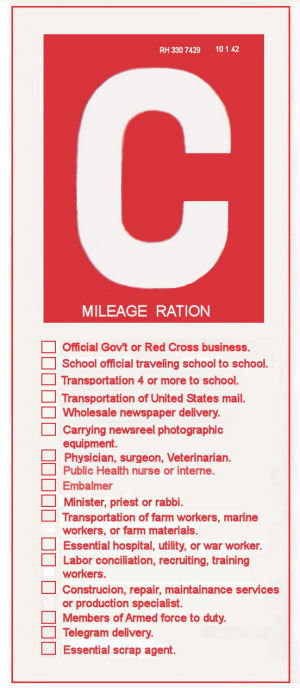
C ration sticker placed on vehicle
When war broke out, Robert Strong Woodward owned two cars, a 1939 Chevrolet "woody" Beach Wagon and a
1936 Packard Phaeton. He easily qualified for an "A" sticker on each. I can remember that he went to the Buckland Rationing Board several times to fight for a higher ration of gas. He was upgraded to a "B" sticker for the 1936 Packard. The "B" ration booklet was for people who were essential to the war effort and allowed him to purchase of up to 8 gallons of gasoline a week. He continued to fight, claiming that he was an an
"en plein air" landscape artist. Because of his disability he made the case that he required additional gasoline in order to support himself, and not be a burden on society. It is not known whether the board decided that his work benefited the war effort, but in my opinion it is more likely that the members of the Rationing Board simply felt compassion for his disability and granted him the higher rations.
By 1945, there were a number of unused ration stamps left over.
Click here to view gasoline Ration Booklets remaining in the Woodward estate. The cards attached indicate that he received a "C" ration card for a 1939 Chevrolet. The C ration was reserved for doctors, Ministers and others professions essential to the war effort. (See list to right). There were also unused stamps for a "1936 Chevy." I specifically recall that RSW only owned a 1939 Chevy and a 1936 Packard. There was no 1936 Chevrolet, but the license plate matched the 1939 Chevrolet Beach Wagon. I also have a vague recollection of him mentioning that the best cards were for use only for the large Packard which, as you might expect, took a lot of gas to run. It is likely that those coupons were used up so none remained in the estate. I distinctly remember that I was regularly able to drive Uncle Rob in the Packard without fear we would run out of gas for that week. We always seemed to have enough.
Many food and material items were in short supply during the war years. Also in short supply was manpower. An enormous number of able-bodied men were in military service. For the first time, businesses and industries began to hire women in an attempt to fill the number of employees necessary to support the war effort. During those years, the local town of Buckland had difficulty keeping the town roads repaired because several of the town workers had been drafted or volunteered for service. I recall several times, whenever the town had a heavy storm or was having difficulty making repairs, that RSW would send his hired man,
Fabian Stone, off to help the town crew. I remember seeing a letter from the Board of Selectmen thanking him for his help.
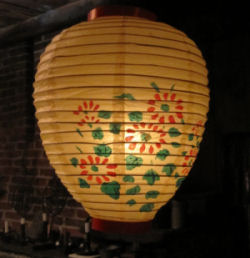
Paper Japanese lantern lit by
a candle in Southwick studio
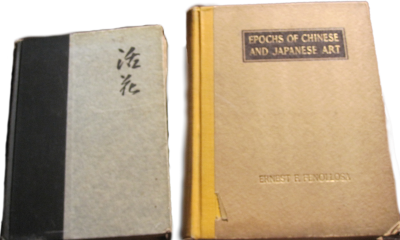
Two sample books on Japanese art from Southwick Studio
I do not remember anything he said about the Germans, but Robert Strong Woodward was a great lover of the Japanese culture and especially their art. RSW owned a number of books on Japanese art. Still today, in one of the studio drawers, are a dozen or more Japanese lanterns, a beautiful dark green Japanese umbrella with wood braces, and a Japanese cricket cage.

Japanese
umbrella
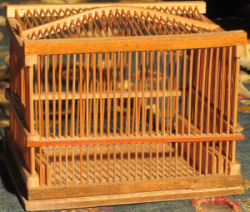
Japanese cricket cage
I remember when Pearl Harbor was attacked. At the time, I was living in the house down on Lower Street and heard the news from FDR on my little AM radio up in my upstairs bedroom. I called out the window to my father who was cleaning out the septic tank at the time, and told him the news. I worked for RSW during those years, mowing lawns. I remember the attack on Pearl Harbor greatly disturbed him. I specifically remember him saying something along the line of "How could those beautiful people have changed so much as to make war against us!" I also remember another quote that was said during a
Studio Supper when we had a couple of Japanese Lanterns illuminated by candles and hung from the studio ceiling. He said that "he loved the Japanese lanterns, but he hated the Japanese." This was most likely due to the success of the American propaganda campaign that portrayed the Japanese as evil and uncivilized.
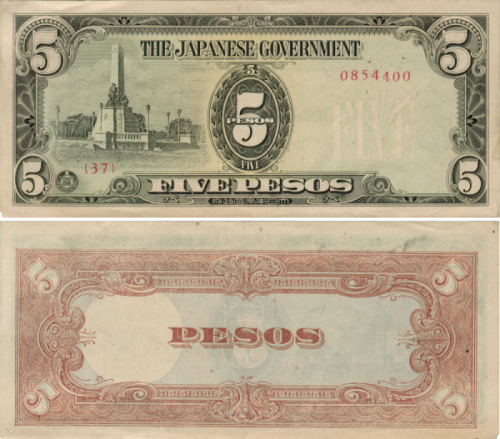
A Japanese Five Peos note remaining in the Woodward estate
One other item remaining in the Woodward estate was a Japanese Five Peso note. This item was found recently and it is not known how it came into the posession of RSW. This was a fiat currency issued by the Japanese government used to pay for military industries, reduce debt, and pay off corrupt generals and government officials. Fiat currency is backed with the good faith of the issuing government without physical backup such as gold or silver. A number of different currencies were created by the Japanese government for various countries as a replacement for the local currency after conquest. Officially known as Southern Development Bank Notes and called Japanese Invasion Money, they were created for a number of countries including the Philippines, Malaya (now Malaysia), North Borneo, Burma, the Dutch East Indies, among others. After the capture of the Phillipines, the Japanese Military confiscated all the local currency from the former Philippine government and the citizens, and replaced it with Japanese Government Notes. After that, anyone possessing other forms of money were subject to arrest. These notes were printed in large amounts and officially a Japanese Peso was worth about 46 cents. The notes were issued in amounts ranging from 1 centavo to 10 Peso. No coins were issued due to the shortage of metal. General Douglas MacArthur ordered the circulation of hundreds of millions of counterfeit Japanese war notes. This was used not only to support local Filipino resistance efforts and Allied intelligence agents on the ground, but also to sabotage the economy of the occupied Philippines. The local Filipinos called the Japanese Peso "Micky Mouse money" or "banana money" and by the end of the war, inflation was so high that the notes were worthless. There are stories that a duck egg would cost 75 Japanese Pesos and a box of matches more than 100. The Five Peso note from the Woodward estate is a second issue note, and shows an image of the Rizal Monument in Manila, a mausoleum built in 1913 to commemorate Jose Rizal. After the war in the early 1950s, the Japanese War Notes Claimants Association of the Philippines collected the old notes and provided receipts. The Filipinos hoped and expected the United States to redeem these notes for U.S. dollars, but in the end, U.S. courts decided that the statue of limitations had expired and no money was paid out.
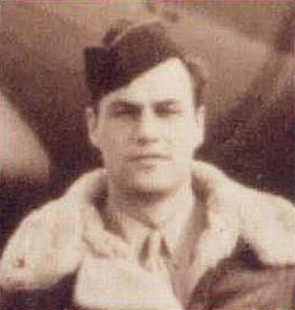
S/Sgt., Frederick V. Richmond
Right Waist Gunner, "Flakstop"
Easthampton, Massachusetts
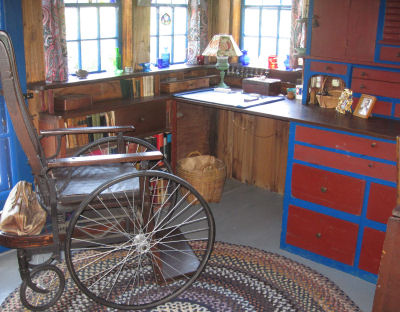
Desk in Southwick Studio where RSW would sit in his
wheelchair and write to military servicemen
During World War II, Robert Strong Woodward religiously wrote daily to a number of the young men who had been drafted or volunteered for military service. During my high school days when I worked for him, I remember seeing him spend several hours every evening, sitting at his desk in the Southwick studio writing. His letters described the ordinary goings-on in the town, births, deaths, and things about his painting etc. Each letter was usually several pages long and his penmanship was often difficult to read. I remember specifically some of his letters were going to Frederick Richmond, a soldier in the African campaign, and son of Clifford Richmond. At age 26, Frederick Richmond (11018903) enlisted on January 3rd, 1942, less than a month after the Japanese attack on Pearl Harbor.
In the mail delivery, there would occasionally be a letter from soldiers overseas, including Frederick Richmond. These were never as long and never as interesting but told some of the things going on in the war. There were always black strike outs by the censor, because all army overseas mail was censored in those days.

B-17G "Flakstop" 42-31373 on a mission over Germany
After the African campaign, I remember that Frederick was sent to England and became part of the European aerial bombing campaign over Germany and the countries occupied by the Nazi. Some two years after he enlisted, these letters stopped coming. We all knew what had happened. Eventually the news came confirming that Sgt. Richmond had been lost in action somewhere between England and Germany. (See newspaper article below). Only then did Uncle Rob stop writing to him.
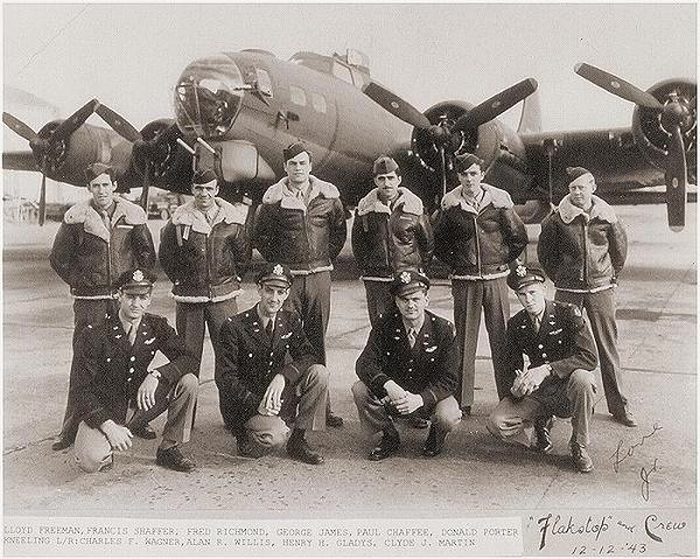
The crew in front of Flakstop, December 12, 1943, Peyote, Texas.
Back - l -r : Lloyd Freeman, Francis Shaffer, Frederick Richmond, George James, Paul Chaffee, Donald Porter
Front - l-r : Charles F. Wagner, Alan R. Willis, Henry H. Gladys, Clyde J. Martin
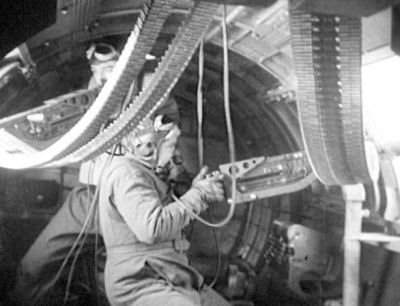
B-17 waist gunners in action during WWII
Recent research reveals that the Sergeant Frederick Richmond flew as a right waist gunner for the 8th Air Force, 452nd Bomb Group on the B-17 Flight Fortress "Flakstop" tail number 42-31373. This airplane was delivered from the factory to the Cheyenne Wyoming airport for completion and modifications on October 26, 1943. On November 9, 1943, the plane arrived in Walla Walla, WA Army Air Base where the crews were assigned and initial training began. From there, the plane went to the dust bowl known as Peyote in west Texas where the crew completed "Phase Training." Flakstop finally arrived at Deopham Green Field in England on January 3, 1944. Flakstop successfully completed four bombing missions over enemy territory.
Missions list for Flakstop
February 8, 1944 - Frankfurt, Germany
February 20, 1944 - Posen-Tutow Poland
February 21, 1944 - Brunswick, Germany
March 4, 1944 - Berlin, Germany
March 6, 1944 - Berlin, Germany
At 7:30 AM on Monday, March 6th, 1944, the B17G took off from Deopham Green airfield , Army Air Force station 142 in Norfolk England. The plane joined a formation at 17,000 feet and proceeded to bomb a group of buildings east of Berlin.
Enemy FW-190s and ME-109s attacked the formation on the way to and from the target. According to official reports, at 3:30 PM, on the way home, the unit was attacked by seven German fighters along the Dutch/German border. "Flakstop" was attacked by a Focke-Wulf Fw190 flown by
Hauptmann (Captain) Hugo Frey. With engines 3 and 4 losing power, and the left wing on fire, the plane could no longer maintain its position in the formation and was losing altitude quickly. The rear section of the plane was badly shot up. The pilot, 2nd Lt. Charles F. Wagner gave the order to bail out.
The crew of Flakstop
Pilot...................2nd Lt. Charles F. Wagner - Mt Angel, OR - KIA
Co-Pilot.............2nd Lt. Alan Richard Willis - Binghamton, NY - EVD
Navigator..........2nd Lt. Clyde J. Martin - Danvers, IL - EVD
Bombardier......2nd Lt. Henry H. Gladys - Crawford County, PA - EVD
Engineer...........Sgt. Donald Arthur Porter - Marinette, WI - EVD
Radio Op..........T/Sgt. Francis Shaffer - Noma, FL - KIA
Ball Turret.........S/Sgt. Lloyd J. Freeman - Norman, OK - POW
R. Waist Gun....S/Sgt. Frederick V. Richmond - Easthampton. MA - KIA
L. Waist Gun.....Sgt. Joseph E. Tracy Jr. - Brooklyn, NY - KIA
Tail Gunner.......T/Sgt. George Lou James - Three Forks, MT - KIA
Pilot Charles Wagner remained at the controls to ensure that all surviving crew members had the chance to escape. Navigator Clyde Martin and bombardier Henry Gladys were the first to leave the stricken plane, followed by co-pilot Alan Willis and engineer/top turret gunner Donald Porter. Robert Strong Woodward's friend, Frederick Richmond was badly wounded in the attack and managed to bail out, but was found dead when he reached the ground. The tail gunner, George James and radio operator Francis Shaffer were killed in flight. Records are not clear, but ball turret gunner Lloyd Freeman survived and became a Prisoner of War. The pilot and left waist gunner were apparently unable to bail out and died when the plane crashed near Staphorst, Netherlands. The four surviving crewman evaded capture and were picked up by the Dutch Underground and eventually returned to England. Of the crew of ten, five died, one became a POW, and 4 evaded capture.
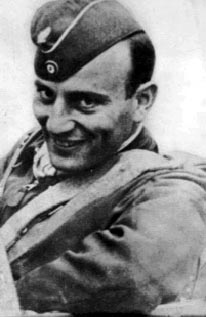
Hauptmann Hugo Frey
German Fw-190 pilot
Officially, Flakstop became the forth B-17 to be shot down and credited to Hugo Frey that day. It was an unprecedented accomplishment to shoot down four heavy bombers in a single mission. It takes a lot of amunition to bring down a single heavy bomber. Most fighter aces would simply run out of ammunition beforehand. However Hugo Frey's accomplishment was short-lived. The gunners of Flakstop along with the combined firepower of other B-17 gunners in the formation, were simultaneously able to fire upon and shoot down the Fw190, killing Hugo Frey. It is very likely that Sgt. Richmond was among the gunners that fired at Hugo Frey's plane. Hugo Frey was credited 32 aerial victories including 25 four-engine bombers and posthumously awarded the Knight's Cross on May 4th 1944. In all, 22 bombers were lost on the raid of March 6, 1944.
In 2011 there is
information found on the internet about a Soldbuch (a type of passbook) belonging to Oberfähnrich ( Officer Candidate, Senior NCO grade) Karl-Friedrich Lange that included his Sofort-Gefechtsmeldung (Immediate After Action Report) from 6 March, 1944. Major Lange flew the mission with Hugo Frey along with Hauptmann Anton Hackl and Unteroffizier Gluttig. This record describes the events on March 6th as follows. The German pilots took off at 2:30PM and at 3:00 PM sighted 60 to 80 B-17s. They attacked the rearmost formation and immediately were engaged by American P-47 Thunderbolt fighters, leading to dog fights. Lange's report claims that he was the one that shot down a B-17 during the attack, which crashed near Staphorst in the Netherlands. According to this record, there is no doubt that Lange shot down the B-17 Flakstop piloted by 2nd Lt Charles F. Wagner with Frederick Richmond on board. This information calls into question whether the downing of Flakstop should be counted toward Frey's total when it more likely should have been counted as Oberfähnrich Lange's victory. Lange returned to Germany but ran out of fuel, and was forced to land successfully in Rheda, Westfalen, Germany at 4:00 PM. Lange was wounded in aerial combat two days later on March 8th, 1944., for which he received the Verwundetenabzeichen 1939 in Silber (1939 Wounded Badge in Silver) on February 14th, 1945.
UPDATE 11/24/2013:
We have recently heard from the daughter of Karl-Friedrich Lange, who found this story about her father. She tells us that her father survived the war, but his left arm was badly wounded. He was unable to continue to play the violin or piano. After the war, he attended a German University (which at that time was controlled by the American Government) to study Engineering Architecture.
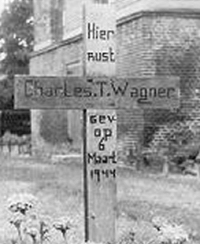
Closeup of grave marker of
Charles Wagner in Staphorst,
The Netherlands. Translation:
Here rests Charles T. Wagner
found on 6 March 1944.
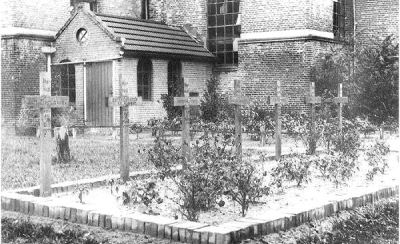
Churchyard Cemetery at Staphorst
Site of graves for the crew of Flakstop
The dead members of the crew of Flakstop were initially buried on March 10th, 1944 at a small churchyard cemetery in Staphorst, The Netherlands. This includes the bodies of Frederick Richmond, Charles Wagner, Joseph Tracy, Francis Shaffer, and George James. These bodies were removed and reburied on December 22, 1945 at the U.S. Military Cemetery in Margraten, the Netherlands. Here, each of the 8,301 graves have been adopted and cared for by a local family in appreciation for the sacrifice the American servicemen made to give the Dutch people their freedom.
Click here for the Memorial Day speech given by the U. S. Army Europe Commander at Margraten.
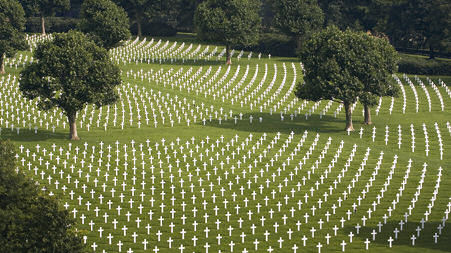
The Netherlands American Cemetery and Memorial at Margraten.
The final resting place of 8,301 soldiers.
Between 1947 and 1960, the U.S. Government ran a program to repatriate the remains of American soldiers killed overseas during the war. It allowed each family to decide whether to have the body returned to the United States at government expense, and allow for private burials in family plots in their hometowns. Many families chose to do this while others decided to let their loved ones remain with his buddies where he fought and died for his country. Since 1960, further removal of bodies has been prohibited.
Frederick Richmond's body was repatriated to the United States on April 26, 1949 by the transport ship USAT Haiti Victory, arriving in New York on May 4, 1949. His final burial was at the Brookside Cemetery, Easthampton, Massachusetts. A United States flag was presented to his father, Clifford A. Richmond in a private service without publicity on June 14, 1949. It is not known whether Robert Strong Woodward attended, or was even aware, of this final service for his friend Frederick Richmond.
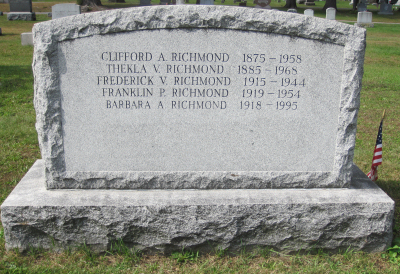
Richmond Family Gravestone, Easthampton, Massachusetts
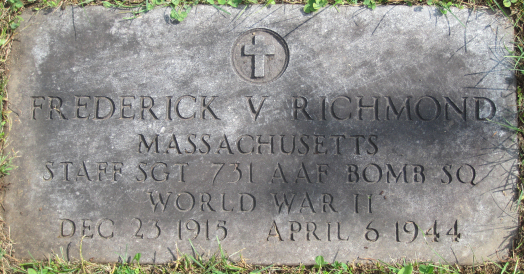
Gravestone of Frederick Richmond, Easthampton, Massachusetts
If you were one of the servicemen who received letters from Robert Strong Woodward during World War II, will you please let us know so that we can include your story too.
MLP
October, 2012
Additional research: LMP
